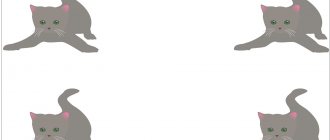Why is it necessary to teach mathematics in kindergarten?
Mathematics in kindergarten helps young smart people develop their abilities. Many parents mistakenly believe that people are divided into two types - humanists and mathematicians - and are sincerely perplexed why their smart guy should pore over solving a problem if he draws or dances well. But this is a mistaken opinion. Even if your child has a pronounced talent, knowledge of mathematical fundamentals will only help him to open up. It has been scientifically proven that children who train logical thinking or solve developmental mathematical problems better understand the material of other subjects at school, can find a way out of a difficult situation, and also develop new talents. If you're still skeptical and think that a lot of the math you learned during your studies was never useful to you, remember the basics. Surely you don’t regret that you learned to count and tell time using an analog clock. You need knowledge about interest at the bank when you take out a loan, and the ability to subtract and add will be useful in the store when you pay for purchases.
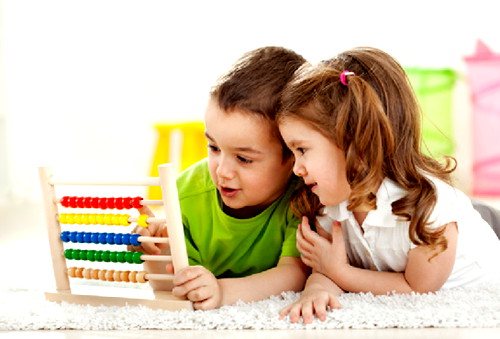
Since new information is best learned in preschool age, math lessons in kindergarten have a place. This science is difficult for many: they are capricious and refuse to do the exercises. Tell your little one that she will encounter basic mathematics every day in her adult life, because she urgently needs this knowledge. Explain that each problem has a solution, draw a picture to make it more interesting for the child to find the correct answer. Setting up your child to learn mathematics is quite simple. You shouldn’t think that the kindergarten will do this for you, since the leader cannot persuade every fidget to work with her individually. In the evening, ask your little one what he did in kindergarten today, and if the topic was unclear to him, explain and help him figure it out.
Mathematics in kindergarten
Mathematics in kindergarten begins in the second junior group, where they begin to carry out special work on the formation of elementary mathematical concepts. Mathematics for preschoolers is usually included in the traditional development program in kindergarten.
Preschoolers’ mastery of mathematics plays an important role not only in preparing for school life, but also for developing logical thinking skills, developing intelligence and understanding.
The section of the site on mathematics in kindergarten for different groups contains many interesting publications for educators on teaching children on various topics:
- Fun for children in the middle group in mathematics
- Summary of the educational activity “Entertaining Geometry” for children of the senior group
- Lesson on the development of elementary mathematical concepts in children of senior preschool age with mental retardation in kindergarten
- Summary of a mathematics lesson at a preschool educational institution
- Lesson on the formation of elementary mathematical concepts in the middle group
- Summary of direct educational activities on the formation of elementary mathematical concepts “Journey to the Land of Logic” preparatory group for children with disabilities
- Mathematics lesson in kindergarten “Cognitive development” on the topic Number 6
- Abstract lessons in mathematics in the 2nd junior group on the topic “Visiting forest animals”
- FEMP “Comparison of numbers 1 and 2, 2 and 2” in kindergarten
- Educational activities in mathematics in kindergarten on the topic “Journey to the land of mathematics”
- Summary of a mathematics lesson on the topic “Journey to a Fairy Tale” in the senior group
- Complex thematic planning for the section on the formation of elementary mathematical concepts of the educational field “Cognition”
- Scenario for a lesson on the formation of elementary mathematical concepts, middle preschool age
- The number line as a means of teaching preschoolers arithmetic skills
- Summary of direct educational activities in mathematics in kindergarten “Consolidating knowledge about numbers 1, 2, 3, 4, 5 Correlating numbers with numbers”
- Lesson for the preparatory group of kindergarten “A fun trip to the country of Mathematics”
Mathematics for young children is quite a complex science, which can cause difficulties while studying at school. In addition, not all children have a mathematical mind, and not all have a natural attraction to the exact sciences. Therefore, developing a preschooler’s interest in mathematics at an early age will greatly facilitate his learning at school. After all, the modern school curriculum is quite rich and far from simple even for a first-grader.
Mathematics Teaching Techniques
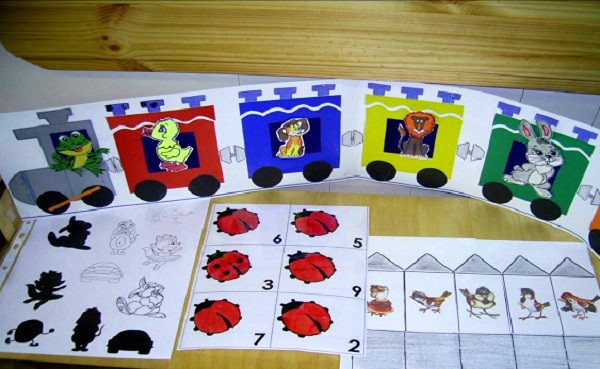
The study of mathematics begins in the junior group of kindergarten. The smart guy gains new knowledge in a visually effective way: he listens to the teacher, works with didactic material. Lessons are held in a playful way with the help of toys and surrounding objects. Such activities attract attention. Some topics are explained with examples - comparing things (long and short, wide and narrow). In order to develop accuracy of perception, teachers use movements, for example, using their hands to describe the shape of a particular figure. So that students can compare two objects and know their common features and differences, teachers ask questions. Working with didactic material helps the preschooler to clearly understand the lesson he has learned. At first, the teacher shows the children how to work with cards or abacus, and then gives a task and helps the preschooler with the solution. In order for young smart people to understand what is required of them, the teacher needs to repeat the demonstration of working with auxiliary material several times. If words appear in the teacher’s story that are unfamiliar to the little ones, he repeats them clearly and slowly several times, and then everyone repeats the term after him in unison.
Important! If your child cannot form complex sentences with the conjunctions “and” or “a”, do not ask him questions like “How many pebbles are in the yellow basket, and how many are in the green?” Divide the question into two sentences, and when the baby answers, help her connect the answers into one whole.
Along with this they search and read:
Aggression in preschool children and family parenting styles and their impact on child development
Formation of initial skills in educational activities
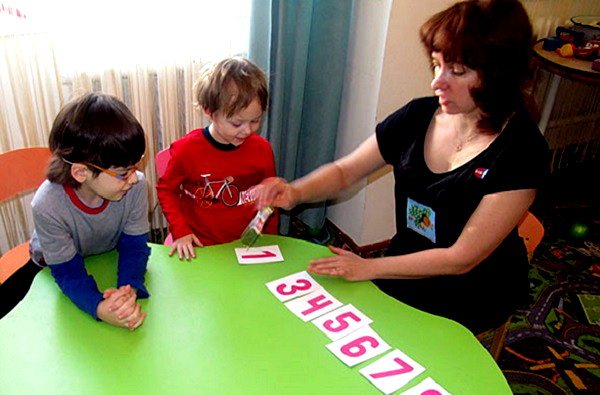
In order for toddlers in the younger group of kindergarten to master the skills of learning activities, they are taught to sit in their place, obey the teacher, answer questions, study together with other fidgety children, start and finish certain actions at the same time as other children, and patiently wait their turn in case of emergency. teacher's employment. A good teacher will always praise a child who is making progress and comfort a child who is upset by the lack of progress.
Since it is difficult for a child to sit in one position for a long time, the teacher arranges frequent breaks in the educational process, rather than correcting the little fidgets with comments.
In order to avoid childish insults, each smart guy receives individual didactic material. Educational supplies are provided before classes begin so that children can explore and touch what they will be working with. Before the lesson, instruction is given, which emphasizes careful handling of the given material, as well as proper use.
Account for children

In order to teach the baby to count, educators use auxiliary materials. For initial lessons, you need cubes and cards numbered from one to five. Cards with numbers are laid out at the bottom of the box, and the cubes are placed on top. Next, the teacher points to each cube and clearly pronounces the corresponding number and asks the little one to repeat after him. Next, the teacher asks the baby to show him the cube with the number “One” or put the cube with the number “Three” in the box.
Important! In order for the young smart guy to remember the numbers on the cubes, use cubes of different colors. The baby will focus its attention on a certain color and associate it with a number. This way, it will be easier for her to answer your question or put the cube in the correct place in the box.
A child will remember numbers best if he encounters them as often as possible. Teachers need to ask kids to count everything that surrounds them in the kindergarten: flowers, beds, plates... With each subsequent training, it will be easier for the little one to count, and in the future name the exact number of objects (that is, she will count in her mind). Counting rhymes for memorizing numbers give excellent results:
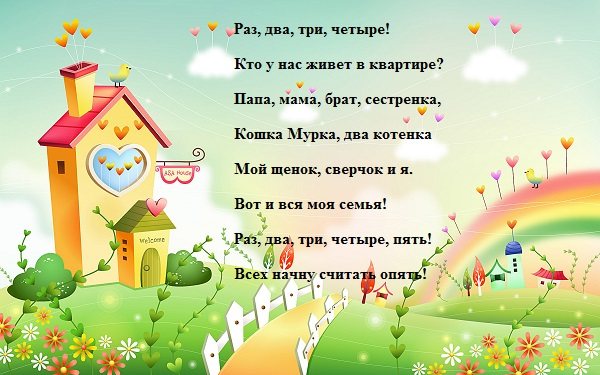
Article “Mathematics in kindergarten”
Thus, traditional educational games and modern technologies help children fall in love with mathematics.
Special requirements are also imposed on visual and handout materials. When preparing for a lesson, the teacher carefully considers in what part of the lesson and how this visual material will be used. It is necessary to dose visual material correctly. Both insufficient use and excess use of it have a negative impact on learning outcomes.
The main condition for the successful implementation of a program for the formation of elementary mathematical concepts is the creation of a developmental environment. According to the requirements of the Federal State Educational Standard, the development environment must be:
• content-rich,
• transformable;
• functional;
• variable;
• accessible;
• safe.
The saturation of the subject-developmental environment should be reasonable. Games should be appropriate to the age of the children and the tasks that are being solved at this stage. Shelves should not be cluttered with excess material. It is advisable to promptly replenish and change the subject-game environment with new games and gaming equipment. Of course, the accessibility of the content of the subject-development environment for children is also important.
Even in early childhood, babies encounter objects that differ in shape, color and quantity. At this age, the child’s basic elementary concepts and abilities begin to form.
The first toys resemble geometric shapes: cubes, construction sets, pyramids. The counting begins with mom’s questions: “Tell me, how old are you?” Parents teach children to name the shapes of toys, their size and quantity.
Through gaming activities, the ability to distinguish between different properties and features of objects is formed. The baby develops his first concept of mathematics, although he does not yet know or realize it. The consciousness of a child in early childhood is chaotic. Parents teach children to compare, group objects, and call them by their proper names. Through visual and objective actions, they help the child remember what he hears based on objective images. By the age of three, a child can already group objects according to their external characteristics, color, and shape. So, for example, a child can put green toys away from red ones, select pencils from a pile of other objects and put them together, can put pyramid rings according to size, in order. When engaging with objects through play activities, the child compares them. This is where the first acquaintance with mathematics begins.
The formation of mathematical concepts is not limited to one area of education; it is integrated with other types of activities. You could say that mathematics is everywhere.
Everything you need to know about geometric shapes

Children will love learning about geometric shapes if learning is presented in the form of a game. Psychologists say that at the age of two, a toddler should know three shapes: square, triangle and circle, and at the age of three - six (a rectangle, an oval and a rhombus are added to those listed above). To make it easier for students to distinguish shapes, educators should follow the following recommendations:
- Show the children a large image of the figures or their layout to make it more clear.
- Repeat the name several times - this way your child will remember it faster.
- Focus on form.
- Alternate requests to name and show one form or another.
- Educational cartoons on this topic help the baby better understand geometry.
- Explain why the figures have this name, count the angles with it.
- An excellent assistant is the sorter. This toy was created so that the little one could learn to insert a certain geometric object into a special shape.
- Draw shapes and ask your child to repeat after you. If your little one is not doing well, hold his pen in your hand and draw lines.
- Make applications from geometric shapes.
Learning with Cuisenaire sticks
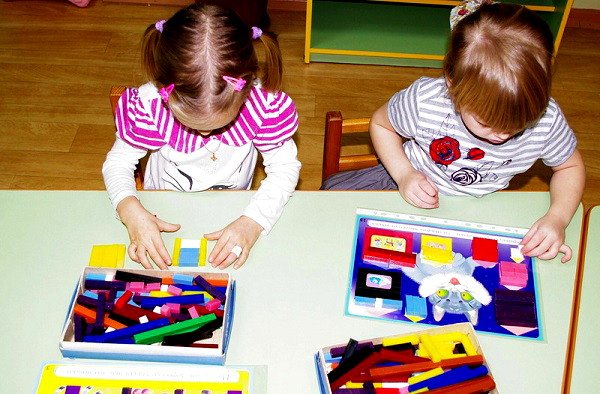
Cuisenaire rods have four sides and a length of one to ten centimeters. They are available in ten colors, each of which comes in a specific length. Cuisenaire's manuals help children learn colors and shades, learn to count, and also understand the ratio of sizes (a red stick is larger than a blue stick, etc.).
To begin with, educators offer Cuisenaire sticks as playing material so that preschoolers learn colors, sizes and shapes. Next, the teacher begins to give simple tasks that students who are already familiar with the material can easily solve.
In order for the lessons to be fruitful, the following lessons must be carried out with the children:
- Tell us more about the sticks, their color and parameters.
- Ask the young smart guy to take a certain number of sticks in each hand.
- Lay out a variety of shapes with your child.
- Build a ladder, starting from the smallest stick and ending with the largest one. Count the steps on the ladder, ask the smart guy to clearly name each number.
- Arrange items in a row according to color or parameters.
- Take out any stick and ask the student to pick up the same one (or a smaller one, a larger one).
Teaching mathematics in kindergarten helps the child find cause-and-effect relationships and understand the elementary laws on which our lives are built. The sooner your baby starts learning mathematics, the more likely it is that you will grow up to be a little prodigy.
Why preparation is needed
This preparation involves not only the acquisition by children of certain knowledge, but also its formation. In such classes, children develop various ideas about the world around them, such as spatial, quantitative, temporal and many others. It is important to develop thinking precisely in preschool age, so that the child learns to solve various kinds of tasks and is ready for the gradual complication of the program. Depending on the age group, children undergo different educational programs in kindergarten. In our group, children, in particular my child, get acquainted with geometric shapes and their colors, which helps develop imagination and imaginative thinking.
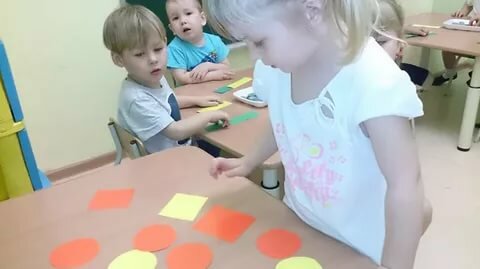
In groups where older children are already working with numbers and solving simple problems.
Such preparation is necessary in preschool age, because it is during this period that the child’s perception of the outside world is formed, and thinking begins to develop from the age of 2. My son finds such activities interesting and fun. Sometimes at home we cut out the same shapes from paper, draw on them, and build pyramids from three-dimensional shapes.
Fun educational games
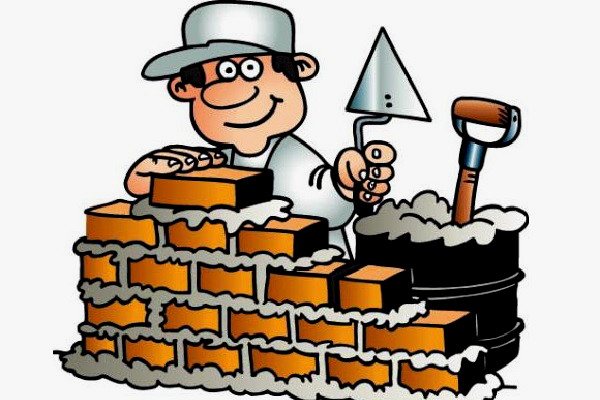
It is much easier for a preschooler to learn math through fun activities and entertainment. We have selected several simple tasks and games that will help you understand the concept of “size” and “measurement”. The incompetent builder A story problem on logic and understanding of measurements. Tell a story, accompanied by illustrations or gestures: “In ancient times, there lived an elderly builder and he worked with a young assistant. A man came and gave the builder a task to build a house. The door parameters had to be suitable for the height and width of the owner. The old builder measured the customer and it was 20 hands high, but the door had to be built by an assistant. After hard work, the builders built the house and installed the door, but it was too low for the owner. Why did it happen so? “If the preschooler could not answer the question, offer him a tower from a construction set, and then measure its height with your palms, and then with the baby’s hands. Ask if the number matches and why. Handkerchief carriages This game allows you to measure distance and roughly understand what a trajectory and route are. For entertainment, you will need several scarves, scarves or pillowcases (preferably in different colors). We tie them together and attach them with a clothespin to the back of the baby’s pants or blouse, making it look like a ponytail or trailers. The child runs from one sign to another, and the mother draws the little one’s attention to the trajectory of the trailers. You can also suggest counting how many cars there are from a chair to a table, etc.
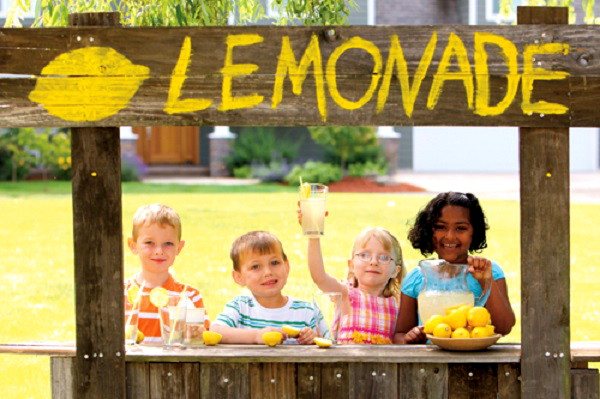
Beverage store If your baby loves to pour water from one container to another, then you can use this to your advantage. Invite your child to open a lemonade stand. You can add a little yellow food coloring to a bowl of water. Let the toys come to the store for a tasty drink and buy liquid in different containers: bottles, cans, glasses. Tell the little seller that a glass costs 1 ruble and let him count how many glasses fit into a liter jar, a 1.5 liter bottle, etc. This is how the preschooler learns the concept of capacity and practices counting. Changes in objects Invite your child to answer the question: “Can the size of an object change?” If he answers in the affirmative, let him give an example of such a thing. If negative, show him the chewing gum, and then stretch it so that the parameters change. Then invite the little explorer to find objects in the house that can change their size. You can also play a ball game. The player catches the ball only when the leader names an object that changes size and hits the ball when the object remains unchanged. Pay little attention to the plants and watch how their size changes over time. The main thing is that the games are fun and the child wants to return to this type of learning. It is better to change the entertainment one by one and find others so that the preschooler does not have time to get bored with them or introduce something new into their content.
Mathematics for kids 2-3 years old mathematics card file (junior group)
Math for kids
Educational games for children 2, 3 years old
Teaching kids math
At the age of 2 or 3 years, the child develops elementary mathematical concepts. He is already familiar with the basic directions: forward, backward, up, down, sideways; is able to distinguish objects by size (large, small, the same), identify their multitude (one, two, many).
It is useful to have sets of identical toys, for example, wooden Christmas trees or mushrooms. Children really like ordinary nesting dolls, which can also be used for story games.
Find a match
The game develops attention, perception, ability to compare
Necessary equipment: cards with drawn paired objects, or paired toys. You can use special kits purchased in the store.
◈ Place cards (toys) in front of the child and ask him to find a suitable pair for each item.
Counting sticks
The game helps to master counting, get acquainted with geometric shapes, and the concept of symmetry.
Necessary equipment: a set of counting sticks (pencils, straws, needles).
◈ Post various pictures or stick figures with your baby - a house, a mushroom, a Christmas tree, a hedgehog, a dragonfly, flowers, a boat, an umbrella, letters. Tell your child what this or that figure is called.
◈ Counting sticks can be used to make wells (square or triangular in cross-section).
The apples are ripe
The game helps you master counting
Necessary equipment: thick colored cardboard, scissors, thread, buttons.
◈ Cut out a tree and some apples from cardboard. Sew small buttons onto the branches, and loops of the appropriate size onto the fruits. Invite your child to fasten the apples to the branches.
◈ During the harvest, the child “unfastens” the apples.
◈ From several apple trees you can make a garden by adding other trees to them, for example, pear, cherry, plum or apricot.
◈ If you have a little patience and add flowers to the apples, this material can be used to illustrate the process of fruit ripening. In this case, it is necessary to tell the child that trees first bloom and then bear fruit.
Help me harvest
The game promotes classification skills
Necessary equipment: dummies or pictures of vegetables and fruits.
◈ Arrange vegetables and fruits (or pictures with their images) mixed. Ask your child to collect and place fruits in one basket and vegetables in the other.
◈ You can then sort vegetables and fruits by type.
Two roads
The game helps develop classification skills
Necessary equipment: cardboard or paper, cars of different sizes.
◈ Cut two strips of different widths from cardboard (paper). Explain to your child that a narrow strip is a road for small cars, and a wide strip is for large cars.
◈ Show how you can determine which stripe is wider by overlapping stripes.
◈ Ask why a large car cannot drive on a narrow road.
◈ Drive your cars on the roads.
◈ By gluing strips of different widths together, you can build an entire network of roads.
Choose the road
The game promotes the development of classification skills and develops the ability to compare.
Necessary equipment: cardboard or paper, cars of different sizes.
◈ Cut two strips of different widths from cardboard (paper). Explain to your child that these are roads for cars.
◈ Ask him to choose cars for which the narrow road is suitable. And vice versa, choose a road along which this or that car can drive.
Matryoshka
The game develops fine motor skills and the skills of comparing objects by size.
Required equipment: a set of nesting dolls.
◈ Almost all children love nesting dolls.
◈ Show your child a large matryoshka doll. Shake her. Open with your child and take out a smaller doll. Put them side by side and compare.
◈ Let the child put the small nesting doll into the large one and take it out.
◈ Gradually show him all the nesting dolls.
Who is faster
The game helps to master the concepts of “long” and “short”.
Necessary equipment: two cars, ropes.
◈ Tie strings to two cars - short and long. Give your child a car with a short string.
◈ Offer to see whose car will “get” to the owner first if everyone winds their own rope around a pencil.
◈ By placing the strings side by side, clearly show what is long and short.
Slide
The game promotes the development of logical thinking.
Required equipment: cardboard or planks.
◈ Make a small slide from cardboard, planks or any other available materials.
◈ You can roll small cars, balls, and dolls down the slide.
◈ Place a cube in front of the slide and show how the rolling car stops when it hits the cube.
Building a tower
The game promotes the development of motor skills, classification, counting, and comparison skills.
Required equipment: cubes of two colors.
◈ Invite your child to build two towers of different colors, after sorting the cubes.
◈ During the construction process, deliberately make mistakes by choosing cubes of the wrong color.
Geometric figures
The game teaches you to distinguish objects by color and shape
Required equipment: five multi-colored circles cut out of cardboard.
◈ Look at one of the circles with your child, telling him: “This is a circle. It is red. What does he look like? Look for round objects in the room. ◈ Explore different colored circles.
◈ After the child has mastered the concept of “circle,” you can move on to other geometric shapes, while expanding the range of colors.
◈ Compare two identical shapes of different colors. Use the association method.
Let's figure it out
The game helps develop classification skills
Required equipment: 3 circles and 3 squares cut out of cardboard.
◈ Shuffle the shapes. Ask your child to help you select only the circles.
◈ After this, color the circles with one color and use a different color to color the squares.
One - there, one - here
The game promotes the development of fine motor skills and teaches counting.
Required equipment: two containers (buckets, boxes), cubes or small items.
◈ Place the cubes in front of the baby and place two buckets or two boxes. Invite your child to put the cubes into boxes.
◈ Taking a cube in your hand and placing it in a box, say: “One goes into this box, here’s another one into another.”
◈ When the child understands the concept of “one,” start taking two objects at a time: “I will put two cubes in this box, and please put two cubes in another box.”
Much is not enough
The game promotes the development of logical thinking and introduces elementary mathematical concepts.
Required equipment: two identical boxes, cubes of the same color.
◈ Put 10 cubes in one box, and 3 in another. Having invited your child to build a tower or a house, ask: “Please bring me a box that contains a lot of cubes.” If the child is at a loss, help him.
◈ After you have built the towers, compare which one is taller (the one with more cubes).
◈ Repeat the words “many” and “little” more often, using them in different situations.
"One step..."
The game helps you master counting
◈ When going up the stairs, count the steps. Don't ask your child to repeat after you, he will do it himself when he understands the essence of the game.
◈ Count how many apples or candies you bought, how many plates you put on the table, etc.
Geometric store
The game helps to study the shape of objects and master counting.
Necessary equipment: toys with clear geometric shapes (ball, cubes, balloons, dominoes, pyramid rings), geometric figures cut out of cardboard.
◈ Invite your child to the store. Explain that in your store toys are sold for money (which are used as geometric figures), but only if the shape of the selected toy matches the shape of the cut out geometric figure. For example, a ball can be bought for a cardboard circle, a cube for a square, etc.
◈ Then complicate the task by explaining to your child that, for example, two squares can buy two cubes.
Hide it in your palm
The game develops the ability to correlate objects by size
Required equipment: small and large balls.
◈ Give the baby some balloons. Say: “Now I’ll show you a trick!” Take a small ball and hide it in your palm. Ask your little one to do the same.
◈ Offer to repeat the trick with a large ball. Explain why a large ball cannot be hidden in the palm of your hand.
◈ Compare the balls with each other, then with the baby’s palm.
◈ Perform similar tricks with any small objects.
Hand out the plates
The game introduces the concepts of “many”, “few”, “one”, “one at a time”
Required equipment: 10 plastic plates.
◈ Give your child a stack of plastic plates. Draw his attention to the amount of dishes, using the words “a lot”, “a whole stack of plates”.
◈ Ask to distribute one plate to each family member or toy. Comment on the child’s actions: “Dad was given a plate, now dad has one plate...”.
◈ After distributing the dishes, make a conclusion: “They handed out a whole stack of dishes and everyone had one plate. Now let's put the plates back together. Look, you have a lot of plates again.”
Fungus to fungus
The game promotes the development of motor skills, teaches how to correlate quantitative sets, and helps to master the concept of “as much as”
Required equipment: 5 yellow and 5 orange mushrooms cut out of cardboard.
◈ Explain the rules to the baby: you lay out one mushroom, the baby must put his own mushroom under it. Draw your child’s attention to the fact that the figures should be laid out from left to right. This will allow the child to acquire the skills necessary in the future to write correctly. Having laid out all the mushrooms, comment: “I put 5 mushrooms, and you put 5 mushrooms. This means there are as many of your mushrooms as mine, they are equally divided.”
◈ Instead of cut out mushrooms, you can use cubes of two colors or any other toys that can be divided into two parts.
Pick a lid
The game develops the skills of classifying and matching objects
Required equipment: pots with lids.
◈ Children enjoy spending time with their mother in the kitchen.
◈ While you are cooking, tell your child that you got the lids mixed up and now you don’t know which lid is for which pan.
◈ Ask your child to help you choose the right size lids.
Grandma's pancakes
The game promotes the development of matching skills, the ability to systematize objects according to a certain criterion
Necessary equipment: 4 circles cut out of paper with a diameter of 3 cm, 4 circles with a diameter of 6 cm, a box for large circles, a box for small circles.
◈ Come up with a plot for the game. For example, my grandmother baked pancakes, large and small. Big ones for mom and dad, small ones for the grandchildren. But all the pancakes got mixed up. We need to help grandma put the pancakes on plates.
